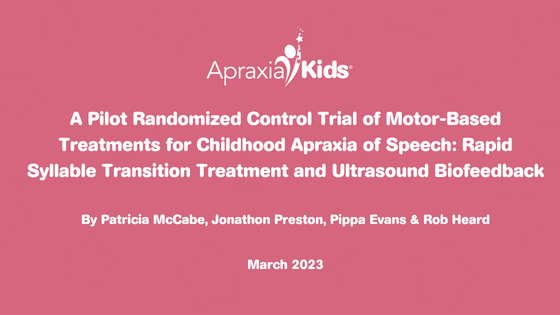
20 Mar A Pilot Randomized Control Trial of Motor-Based Treatments for Childhood Apraxia of Speech: Rapid Syllable Transition Treatment and Ultrasound Biofeedback
There is a real need to show that treatments for CAS work and to compare them with each other so that we know which one is the right one for an individual child. This paper compared Rapid Syllable Transition Treatment (ReST) and ultrasound biofeedback as treatments for 14 children with CAS aged 6-13.
Treatment was provided twice per week for six weeks in a university clinic. Children were randomly allocated to get one of the treatments for the whole time. The included children had no other significant disorders although they all had difficulties with expressive language and speech accuracy. There were no significant differences between the two groups of children before the research started.
Both groups of children (those who got ReST and those who got ultrasound) improved in treatment and there was no difference between groups in how much they improved. The accuracy of the children’s speech also improved when they said untreated words and sentences and these changes were maintained for at least one month after the treatment was completed. At that one month assessment, we were also able to measure changes in the accuracy of the children’s prosody (improved lexical stress and/or reduced syllable segregation) in both groups of children. It is possible that a bigger sample of children would have shown differences between the two treatments.
Either ReST or ultrasound biofeedback may be appropriate treatment options for school aged children with CAS.
This study was funded by Apraxia-Kids and the paper is available for free (open access) by following this link: https://pubs.asha.org/doi/full/10.1044/2022_AJSLP-22-00144?af=R .
There is a real need to show that treatments for CAS work and to compare them with each other so that we know which one is the right one for an individual child. This paper compared Rapid Syllable Transition Treatment (ReST) and ultrasound biofeedback as treatments for 14 children with CAS aged 6-13.
Treatment was provided twice per week for six weeks in a university clinic. Children were randomly allocated to get one of the treatments for the whole time. The included children had no other significant disorders although they all had difficulties with expressive language and speech accuracy. There were no significant differences between the two groups of children before the research started.
Both groups of children (those who got ReST and those who got ultrasound) improved in treatment and there was no difference between groups in how much they improved. The accuracy of the children’s speech also improved when they said untreated words and sentences and these changes were maintained for at least one month after the treatment was completed. At that one month assessment, we were also able to measure changes in the accuracy of the children’s prosody (improved lexical stress and/or reduced syllable segregation) in both groups of children. It is possible that a bigger sample of children would have shown differences between the two treatments.
Either ReST or ultrasound biofeedback may be appropriate treatment options for school aged children with CAS.
This study was funded by Apraxia-Kids and the paper is available for free (open access) by following this link: https://pubs.asha.org/doi/full/10.1044/2022_AJSLP-22-00144?af=R .
Credentials:
Hours of Operation:
Treatment locations:
Address:
,
Phone:
Email:
Overall Treatment Approach:
Percent of CAS cases:
Parent Involvement:
Community Involvement:
Professional consultation/collaboration:
Min Age Treated:
Max Age Treated:
Insurance Accepted:




